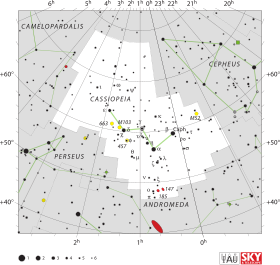PZ Cassiopeiae
PZ Cassiopeiae
PZ Cassiopeiae est l'étoile brillante située en haut et à droite de cette image infrarouge de WISE.
| Ascension droite | 23h 44m 03,28104s[1] |
|---|---|
| Déclinaison | +61° 47′ 22,1823″[1] |
| Constellation | Cassiopée |
| Magnitude apparente | 8,90[2] (8,2 - 10,2[3]) |
Localisation dans la constellation : Cassiopée | |
| Type spectral | M3I[4] |
|---|---|
| Indice U-B | +1,32[2] |
| Indice B-V | +2,58[2] |
| Variabilité | SRc[5] |
| Vitesse radiale | −45,68 ± 0,68 km/s[6] |
|---|---|
| Mouvement propre |
μα = −4,15 mas/a[1] μδ = −3,55 mas/a[1] |
| Parallaxe | 0,356 ± 0,026 mas[7] |
| Distance |
2 810+220 −190 pc (∼9 170 al)[7] |
| Magnitude absolue | −7,89[4] |
| Rayon | 1 190 (ou 1 940) R☉[4] |
|---|---|
| Gravité de surface (log g) | −0,5[4] |
| Luminosité | 240 000–270 000 L☉[7] |
| Température | 3 600 K[4],[7] |
| Âge | 8 – 10 × 106 a[7] |
Désignations
PZ Cassiopeiae est une étoile supergéante rouge située dans la constellation de Cassiopée, et une étoile variable semi-régulière. Elle est une des plus grandes étoiles connues avec un rayon estimé de 1 190 (ou 1 940) R☉ (soit 830 millions à 1,35 milliard de km). Sa distance a été estimée à environ ∼ 9 170 a.l. (∼ 2 810 pc) de la Terre[7].
Compagnon[modifier | modifier le code]
PZ Cas a un compagnon, une étoile de 13e magnitude située à 12"[9].
Références[modifier | modifier le code]
- (en) F. Van Leeuwen, « Validation of the new Hipparcos reduction », Astronomy & Astrophysics, vol. 474, no 2, , p. 653 (DOI 10.1051/0004-6361:20078357, Bibcode 2007A&A...474..653V, arXiv 0708.1752)
- (en) J. R. Ducati, « VizieR Online Data Catalog: Catalogue of Stellar Photometry in Johnson's 11-color system », CDS/ADC Collection of Electronic Catalogues, vol. 2237, (Bibcode 2002yCat.2237....0D)
- (en) L. L. Kiss, G. M. Szabó et T. R. Bedding, « Variability in red supergiant stars: Pulsations, long secondary periods and convection noise », Monthly Notices of the Royal Astronomical Society, vol. 372, no 4, , p. 1721 (DOI 10.1111/j.1365-2966.2006.10973.x, Bibcode 2006MNRAS.372.1721K, arXiv astro-ph/0608438)
- (en) E. M. Levesque, P. Massey, K. A. G. Olsen, B. Plez, E. Josselin, A. Maeder et G. Meynet, « The Effective Temperature Scale of Galactic Red Supergiants: Cool, but Not as Cool as We Thought », The Astrophysical Journal, vol. 628, no 2, , p. 973 (DOI 10.1086/430901, Bibcode 2005ApJ...628..973L, arXiv astro-ph/0504337)
- (en) A. M. Le Squeren, P. Sivagnanam, M. Dennefeld et P. David, « A Complete Survey of OH / Infrared Objects from the IRAS LRS Sources Within a Domain of the Color Diagram », Astronomy & Astrophysics, vol. 254, , p. 133 (Bibcode 1992A&A...254..133L)
- (en) B. Famaey, A. Jorissen, X. Luri, M. maior, S. Udry, H. Dejonghe et C. Turon, « Local kinematics of K and M giants from CORAVEL/Hipparcos/Tycho-2 data. Revisiting the concept of superclusters », Astronomy & Astrophysics, vol. 430, , p. 165 (DOI 10.1051/0004-6361:20041272, Bibcode 2005A&A...430..165F, arXiv astro-ph/0409579)
- (en) K. Kusuno, Y. Asaki, H. Imai et T. Oyama, « Distance and Proper Motion Measurement of the Red Supergiant, PZ Cas, in Very Long Baseline Interferometry H2O Maser Astrometry », The Astrophysical Journal, vol. 774, no 2, , p. 107 (DOI 10.1088/0004-637X/774/2/107, Bibcode 2013ApJ...774..107K, arXiv 1308.3580)
- (en) V* PZ Cas -- Red Supergiant sur la base de données Simbad du Centre de données astronomiques de Strasbourg.
- (en) Mason, Gary L. Wycoff, William I. Hartkopf, Geoffrey G. Douglass et Charles E. Worley, « The 2001 US Naval Observatory Double Star CD-ROM. I. The Washington Double Star Catalog », The Astronomical Journal, vol. 122, no 6, , p. 3466 (DOI 10.1086/323920, Bibcode 2001AJ....122.3466M)
Lien externe[modifier | modifier le code]
- (en) PZ Cassiopeiae sur la base de données Simbad du Centre de données astronomiques de Strasbourg.


